Submitted by chandra on Thu, 2014-12-18 21:08
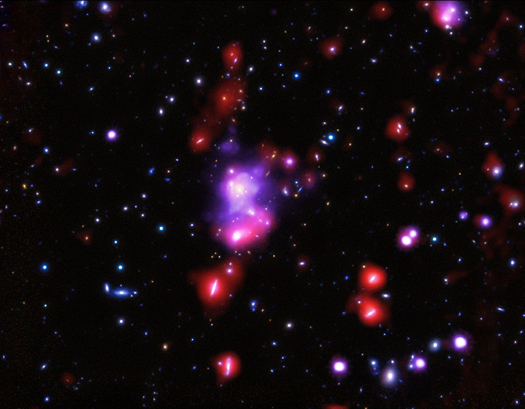
A newly discovered galaxy cluster is the most massive one ever detected with an age of 800 million years or younger. Using data from NASA's Chandra X-ray Observatory, astronomers have accurately determined the mass and other properties of this cluster, as described in our latest press release. This is an important step in understanding how galaxy clusters, the largest structures in the Universe held together by gravity, have evolved over time.
Submitted by chandra on Thu, 2014-12-11 13:48
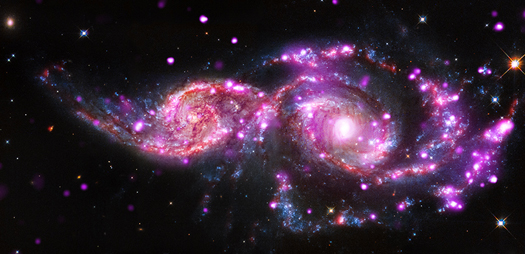
At this time of year, there are lots of gatherings often decorated with festive lights. When galaxies get together, there is the chance of a spectacular light show as is the case with NGC 2207 and IC 2163
Located about 130 million light years from Earth, in the constellation of Canis Major, this pair of spiral galaxies has been caught in a grazing encounter. NGC 2207 and IC 2163 have hosted three supernova explosions in the past 15 years and have produced one of the most bountiful collections of super bright X-ray lights known. These special objects - known as "ultraluminous X-ray sources" (ULXs) - have been found using data from NASA's Chandra X-ray Observatory.
Submitted by chandra on Mon, 2014-12-08 11:23
The people who work at the Chandra X-ray Center truly have many talents. Take, for example, Sherry Winkelman who works on the Chandra Data Archive, which houses the vast amounts of Chandra observations taken over the lifetime of the mission.

Just recently, Sherry’s quilt called "Interchange," an abstraction of the Chandra archive, was accepted for the 2015 Smithsonian Community Committee art exhibition, Artists at Work show. The quilt will be on exhibit in the Ripley Center in Washington, D.C. from February 4 through May 1, 2015.
Submitted by chandra on Wed, 2014-12-03 13:32
A couple of weeks ago, the "15 Years of Science with Chandra" symposium was held in Boston, Mass. It was foremost a chance to bring scientists together who are doing some of the most fascinating research with Chandra on everything from black holes to neutron stars to dark matter.
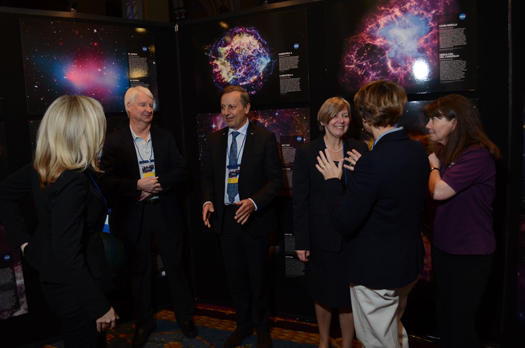
Submitted by chandra on Mon, 2014-11-24 14:19
Last week, Tech Collective, Rhode Island’s industry association for Information Technology and Bioscience, announced ten Rhode Island IT practitioners, digital media designers, and entrepreneurs as its 2014 Tech10 Award recipients. Our own Kimberly Arcand, a Rhode Island native, was recognized for work as the Visualization Lead for NASA’s Chandra X-ray Observatory. Kim shared her thoughts on some important topics in science communication, which we include below.

STEM
The “STEM” fields of science, technology, engineering and mathematics seem inextricably linked, particularly in the field of space science. We can work from wherever there’s a connected computer – being able to access data from a spacecraft, orbiting a third of the way to the Moon, because of the telecommunications system/network and software that connects the observatory to the Deep Space Network and down through to – eventually - my laptop. My particular piece in this is directing the translation of the data and information into forms that others can use. That process happens in many ways, whether through the more literal form of processing binary data into visual representations of a cosmic object, or tweeting about a recent science result.
Submitted by chandra on Wed, 2014-11-19 12:40
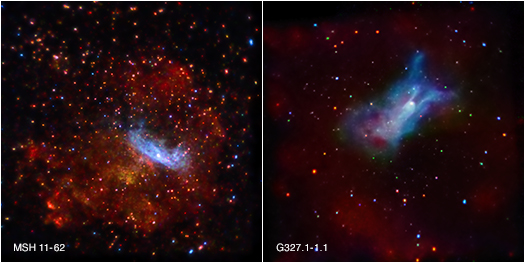
A supernova that signals the death of a massive star sends titanic shock waves rumbling through interstellar space. An ultra-dense neutron star is usually left behind, which is far from dead, as it spews out a blizzard of high-energy particles. Two new images from NASA's Chandra X-ray Observatory provide fascinating views - including an enigmatic lobster-like feature - of the complex aftermath of a supernova.
Submitted by chandra on Tue, 2014-11-18 11:15
PART 2: #sts93 (PART 1)

Preparation for Launch
The size and weight distribution of the Chandra X-ray Observatory and its booster (called the Inertial Upper Stage, or IUS) posed extra risks for the crew of STS-93. Space Shuttle Columbia was the heaviest shuttle and the bulk of the weight from the two components in the payload bay – the heaviest ever to fly -- was located in the aft of the Shuttle. This meant it could be extremely dangerous – or fatal -- if for some reason, they had to return to Earth with Chandra and IUS in the payload bay.
Submitted by chandra on Mon, 2014-11-17 09:47
PART 1: #womeninstem

STS-93 Launch
Shortly after midnight on July 23, 1999, the Space Shuttle Columbia blasted off from the launch pad at the Kennedy Space Center in Florida. The mission – dubbed STS-93 in NASA shorthand – had several purposes to achieve and scientific experiments to perform.
Submitted by chandra on Wed, 2014-11-12 00:20
 Andrea Peterson
Andrea PetersonWe are pleased to welcome Andrea Peterson as a guest blogger today. Andrea is a co-author of a paper reporting that the supermassive black hole at the center of our galaxy may be a source of highly energetic neutrinos, as explained in our latest press release. Andrea recently completed her Ph.D. at the University of Wisconsin-Madison, where she studied particle phenomenology. She is now a postdoctoral researcher at Carleton University in Ottawa, Ontario. She was born and raised in Minnesota, and received her undergraduate degree from Harvard University. She hopes to live somewhere warm someday.
Neutrinos are tiny particles that zoom through the universe at nearly the speed of light. They interact very rarely, so most of the time they pass right through you, me, or any object they encounter. Their ghost-like nature can be a boon for astronomers: they travel from their sources without getting absorbed or deflected. We can use neutrinos to get a clear picture of the very distant universe.
You may have noticed a problem, though. If they don’t interact very often, how can we catch them here on Earth? They have to interact with our detector to be seen!
The solution is size. The bigger the detector, the more stuff there is for the neutrinos to bump into, increasing the chances of detection. The IceCube Neutrino Observatory, located at the South Pole, uses a cubic kilometer of ice to trap neutrinos. In three years, this giant detector has collected 36 extremely energetic neutrinos that are likely to have come from astrophysical sources.
Submitted by chandra on Wed, 2014-11-12 00:10
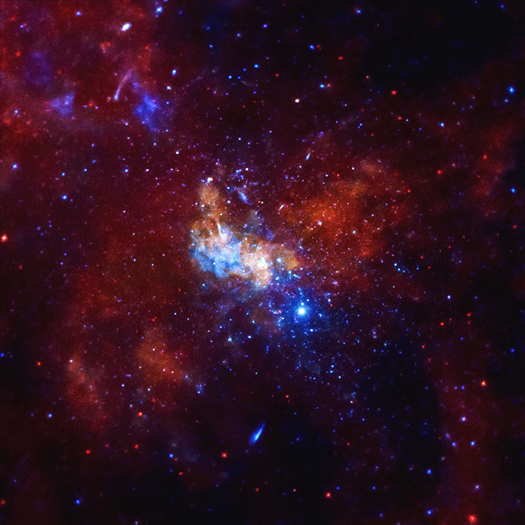
The supermassive black hole at the center of the Milky Way, seen in this image from NASA's Chandra X-ray Observatory, may be producing mysterious particles called neutrinos, as described in our latest press release. Neutrinos are tiny particles that have virtually no mass and carry no electric charge. Unlike light or charged particles, neutrinos can emerge from deep within their sources and travel across the Universe without being absorbed by intervening matter or, in the case of charged particles, deflected by magnetic fields.
Pages